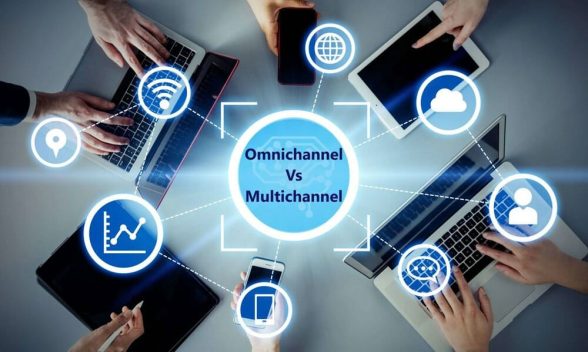- Resources
- Omnichannel vs Multichannel contact center
Omnichannel vs Multichannel contact center

Customers don’t care whether you are communicating with them via a call center, a multichannel contact center, or an omnichannel CX hub. What they do care about is results and the quality of their experience.
Today customers use a variety of platforms, services, and channels. Whether it’s text, live chat, Facebook, or WhatsApp, they like to reach out to businesses via these same channels that they use for their work and personal life. Plus, they demand easy 24/7 access, personalized, and consistent experience across all these touchpoints.
Businesses are working hard to meet and exceed these customer expectations. In the process of doing this, contact centers often use the terms omnichannel and multichannel interchangeably. However, in reality, an omnichannel and multichannel contact center differ greatly in terms of both operations, as well as customer experience. This article explains how.
Let’s get to the nuts and bolts!
An omnichannel and multichannel contact center vary right from their very definition:
An omnichannel contact center solution is one where all support and communication channels are unified in the backend. An agent can quickly access this through an easy-to-use simple dashboard, so she can view all the data required for a contextual and personalized conversation with a customer.
A multichannel contact center solution also allows agents to interact with customers across a plethora of channels: voice, email, web forms, social media, fax, chat, and text. Thereby providing customers the flexibility to choose the channel(s) to engage with a company. Channel interactions, however, work in isolation and are not integrated on the backend.
In this article, we will explore:
Comparison between a Multichannel and an Omnichannel Contact Center
While both solutions offer customers a vast choice of touchpoints to engage with a business, they use contrasting technologies that offer different end goals, meet different business challenges, and require differing levels of agent training and infrastructural needs.
Difference in technology
In a multichannel contact center solution environment, each communication channel works in isolation. Customer communications and information are not unified. Agents access customer interaction history by toggling between tabs.
An omnichannel contact center, on the other hand, offers a unified communication solution where channels are unified on the back end. Agents can easily access customer engagement history through a dashboard to have a more personalized, meaningful, and contextual conversation with customers.
To truly deliver on the omnichannel promise, proper integration of an omnichannel contact center solution is critical. Comparatively, it’s more evolved and complex. For e.g. there needs to be proper integration of new channels with existing ones; integrating channels with one another, and with existing business and back-office processes.
Difference in agent training
In a multichannel contact center solution, agents receive channel-specific training. They’re trained to manage specific channels to meet customer needs that arose through a specific channel.
In an omnichannel contact center environment, agents are trained to triage customer inquiries across channels. They also need to know the technology inside out to truly deliver exceptional service across the customer journey. Agent training needs to be methodical, requires time and effort.
Differences in business challenges
In a multichannel contact center solution, standardized and personalized customer experience across platforms is not uniform or streamlined. Agent and customer effort are required to optimally meet customer needs, especially if customer interactions have been across channels.
In an omnichannel contact center on the other hand, as mentioned earlier, proper implementation is complex and agent training is more evolved and the learning curve steeper.
Differences in business impact & output
Relative to a multichannel contact center solution, an omnichannel contact center is better at managing the overall CMX.
Research1 shows that an omnichannel customer experience predicts a 91% higher year over year increase in customer retention. Since it’s unified it also reduces both agent and customer burden. Thereby leading to greater conversions, sales, and overall improved profitability.
Here’s a nifty chart that enumerates the key differences between these two solutions:
| Multichannel contact center | Omnichannel contact center | |
| Multichannel customer engagement | yes | yes |
| Unified customer journey | X | yes |
| Consistent standardized & personalized service across channels | X | yes |
| Streamlined dashboard for easy access to customer engagement history | X | yes |
| Agent training | Specialized channel-specific training for agents. | Agents are trained to triage customer inquiries across channels. |
| Key metrics | Channel-specific performance metrics. Metrics (conversion, etc.) to evaluate the impact by channel. | Overall business performance metrics as well a channel specific impact |
Conclusion
Today, businesses have the freedom to choose between two great yet fundamentally contrasting contact center solutions.
Sources:
https://www.customercomms.com/blog/wp-content/uploads/mckinsey-article.pdf
https://bestvpncanada.ca/what-is-a-vpn/
CCW Special Report 2020 Predictions
To make the optimal choice, businesses should:
- Learn everything about both multichannel and omnichannel contact center solutions.
- Evaluate which type of contact center solution will optimally meet business goals.
- Take a hard look at their service offerings, customer profile, and customer interaction journey to optimally set up systems.
- Periodically re-examine how your choice of model is functioning. Identify improvement opportunities and translate gaps in iterative implementation initiatives.







